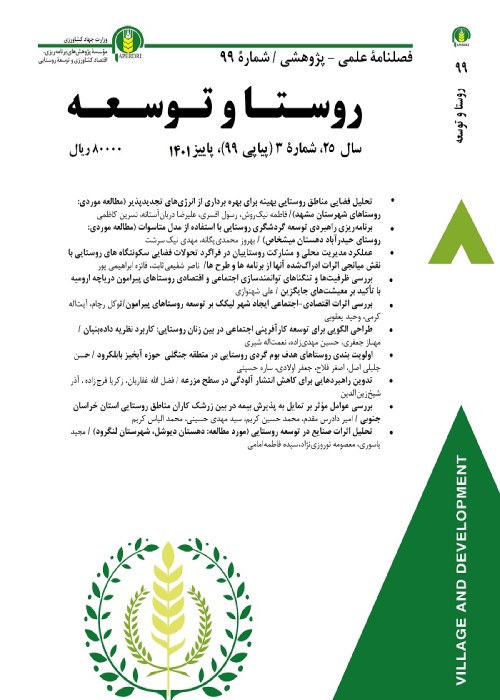Analysis and Investigation of Factors Affecting the Acceptance of Information and Communication Technology in Rural Communities (Case Study: Villages of Torghabe Shandiz County)
The most important issue regarding the impact of information and communication technologies on rural development is its acceptance by local communities, which is influenced by various factors such as its compatibility with local conditions, the level of awareness of communities about the role of information and communication, and the level of efficiency. Shandiz district is one of the districts of Torghabe Shandiz County, which has witnessed the expansion of access to information and communication technology services in recent years. Considering the functional position of this region in the field of tourism and its related businesses, the development and access to information and communication technologies and improving the level of awareness of how to use it, can provide the economic and social development of the villagers of this region. In this regard, the present research aims to evaluate the level of acceptance of information and communication technologies in the villages of this district and also to explain the factors affecting the acceptance of information and communication technologies by the villagers in order to develop its effects in the region.
The current research is an applied study that was conducted in the field. Data collection methods include documentary studies, observation, interviews and completing a researcher-made questionnaire in a rural community in Torghabe Shandiz county. The statistical population of the research was randomly selected 12 villages. Also, the sample size of the research includes 196 households, which was determined by Cochran's formula with an error of 0.07, and by correcting the samples of less than 10 households in some villages, the number of samples increased to 234 people. In order to check the reliability of the questionnaire and indicators made from Cronbach's alpha, and to check the validity of the questionnaire, the opinions of university professors and experts in the field of information and communication technology and rural studies were considered. Descriptive and inferential statistics were used to analyze the collected data.
Chi-square test was used to check the variable status of information and communication technology acceptance level. Using the chi-square test, the significance value for all indicators was calculated to be less than 0.05. All indicators of acceptance of information and communication technology are meaningful and can be generalized to the whole society.Examining the relationship between individual variables (age, education and income) with the acceptance of information and communication technology shows that there is no relationship between the level of income and the acceptance of information and communication technology. But there is a direct and positive relationship between education level and technology adoption. Also, there is an inverse relationship between age and acceptance of technology.In order to measure and compare the average level of acceptance of information and communication technology among the users of communication technologies, the t-test with two independent groups was used. According to the results, people who do not believe in the use of information and communication technologies have a lower level of acceptance than people who consider the use of these technologies useful and effective. Also, single people have a higher level of acceptance than married people, and people who have gardens and handicrafts use communication and information technologies more. Having a computer and having access to the Internet also increase the level of acceptance.In the following, exploratory factor analysis was used to extract factors affecting acceptance. A total of 4 factors (education and facilities, cultural and religious, economic and individual) were extracted and named according to the nature of the variables.In order to investigate the influence of factors affecting the acceptance of information and communication technology on the villagers' acceptance of these technologies, the simultaneous regression model (Enter Method) has been used. The coefficient of determination that shows the degree of explanation of the variance and changes of the dependent variable i.e. the degree of acceptance of information and communication technologies by the 4 independent variables i.e. education and facilities, cultural and religious factors, economic and individual factors, is equal to 0.84 which shows that the indicators of the independent variable explain 84% of the changes related to the dependent variable.Among the independent variables, the "cultural and religious" variable has the greatest role in predicting changes in the dependent variable. After that, there is the variable of education and facilities, and finally, the economic variable is able to predict the changes of the dependent variable by 0.35%.
According to the objectives of the research, the findings of the research confirm that the acceptance of new technologies among the villagers depends on many individual and general factors such as their education level, age, etc. Also, the research findings show that single people have a higher level of acceptance than married people. Also, according to the results, the use of information and communication technology has been more among the villagers who own gardens or produce handicrafts, and the reason for this was the use of this tool for selling and marketing processed products and increasing the income of this group of villagers. The findings of the field investigations showed that Virani village, being in a short distance from the city of Mashhad and having furniture production workshops, generally has got more connections with the city dwellers and tourists, and also has more modern technologies for selling and marketing of its products and, therefore, the level of acceptance and use of information and communication technologies is higher among the residents of this village.Considering the increase in the use of information and communication technologies in rural areas, as well as the youth-oriented nature of the users of these technologies, in order to guide the correct use and reduce the challenges in this area such as corruption and fraud, the need to strengthen and provide educational and cultural background for adequate acceptance of technologies is one of the most important requirements. According to the results obtained, training and creating the right facilities, removing religious misconceptions and cultural doubts, increasing transparency in the field of different dimensions of technologies in different groups, highlighting the advantages and desirable uses of technologies to villagers and controlled and guided access to it can greatly help the basic and correct acceptance of technologies in rural areas. In this regard, educational and cultural institutions, media and families play an important role.
- حق عضویت دریافتی صرف حمایت از نشریات عضو و نگهداری، تکمیل و توسعه مگیران میشود.
- پرداخت حق اشتراک و دانلود مقالات اجازه بازنشر آن در سایر رسانههای چاپی و دیجیتال را به کاربر نمیدهد.



